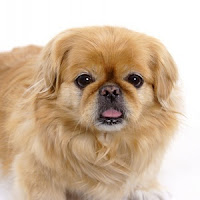BAT EARS look like they are almost too big for the dog. They stand up, and they nice and wide at the bottom. Chihuahuas have ears like this, and so do Cardigan Welsh Corgis.
BLUNT-TIPPED EARS are sometimes called TULIP EARS, except in Europe, where tulip ears might mean the same as bat ears. Or tulip ears might mean ears that are supposed to be folded over, but which stand up and look funny. In a show dog, this is a no-no, but in a pet dog, it is just cute. Anyway, some breeds with blunt-tipped ears are Chow-Chows and French Bulldogs.
BUTTON EARS fold over in the middle, so that the top part of the ear hides the opening to the ear. Jack Russell Terriers have button ears, and so do Fox Terriers and Lakeland terriers.
CANDLE FLAME EARS are shaped like, well, candle flames. The only breed that has them is the English Toy Terrier.
The COCKED EAR is also called a SEMI-CROPPED or SEMI-PRICK EAR. It's sort of like a button ear, except that it doesn't fold over halfway, like a button ear does. It just folds over a little bit at the tip. Breeds with this kind of ear include shelties, collies, and pitbulls.
DROP or PENDANT EARS look kind of different in different breeds. This sort of ear hangs down from the spot where it is attached to the side of the dog's head. Sometimes these ears make a full drop, and sometimes they are folded. So Basset Hounds and Skye Terriers both have drop ears, even though they don't look very much alike.
FILBERT-SHAPED EARS are mostly only found in Bedlington Terriers. Supposedly their ears are shaped like filbert nuts, but they don't look much like filberts if you ask me.
FOLDED EARS or ROLLED EARS are long, pendant ears that sort of fold over along the edges. Bloodhounds and Field Spaniels have ears like this.
HOODED EARS are what basenjis have, and I can tell you from personal experience that they are an excellent kind of ear to have! In a hooded ear, both sides of the ear curve forward, so the ears are shaped like a hood.
PRICK or ERECT EARS stand up stiffly. They might be this way naturally, or they might stand up because they were cropped. Examples of breeds with prick ears are German Shepherds and Pomeranians. But one thing that's confusing to me is that when you look at a German Shepherd from the side, the ears look pretty much hooded, like a basenji's, so I'm not sure why they are called "prick ears" and not "hooded ears."
TRIANGULAR EARS are prick ears that form a triangle with all the sides the same length. Mom says this is called an equilateral triangle, and she knows this because long ago, at the dawn of time, she took a geometry class. Anyway, some breeds with triangular ears are the Siberian Husky, the Norwegian Buhund, and the Pyrenean Mountain Dog.
ROSE EARS are small drop ears that fold over and then backwards. Greyhounds have them, and so do Italian Greyhounds, Whippets, and Bulldogs. My brother Mel has them, which is one things that makes him look like he might be a whippet mix. Also Nicky has them, of course.
V-SHAPED EARS are longer, triangular ears and are usually also drop ears. Examples of breeds with V-shaped ears are Hungarian Vizslas and Bullmastiffs.
HEART-SHAPED EARS are the kind of ears that breeds like Portuguese Water Dogs and Pekingese have, except it's hard to tell what shape ears they have because their ears are so hairy.
LOBE-SHAPED EARS are required by the breed standards of dogs like English Springers, Irish Water Spaniels, and Cocker Spaniels.
Well, that's pretty much all the ear shapes I could find names for. Now you just need to study them, and we will have a quiz tomorrow!

















No comments:
Post a Comment